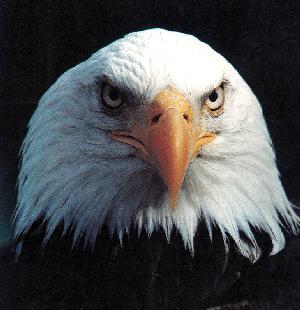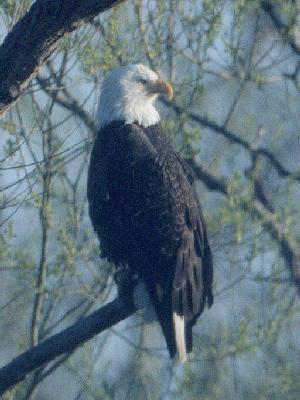
Zoo Books Copyright © 1985 all rights reserved.

Juhani Kyyrö, Hannu Ekblom, Ilkka Heiskanen & Hannu Hautala
•STATUS: Endangered, 1967; Threatened, 1995. With healthy a population of 30,000 individuals in Alaska.
In 1980, the Great Lakes Bald Eagle population experienced almost complete reproductive failure. There were only three active nests along the north shore of Lake Erie in that year, and only one nest produced young.
In 1983, the Southern Ontario Bald Eagle Monitoring Project, led by the OMNR and the Canadian Wildlife Service (CWS) was initiated 2005 REPORT.
Eagles are large predatory birds that have been symbols of power, courage, and immortality since ancient times. The more than 50 species all belong to the hawk family, Accipitridae, order Falconiformes. Eagles inhabit all major land regions except Antarctica and New Zealand. Eagles prey on such small animals as fish, rodents, birds, snakes, turtles and rabbits. They have very sharp eyesight and hunt while soaring high in the air or watching from a high perch. The eagles swoop down at great speed to make the kill with their powerful talons. With talons and beak they pull apart a prey that is too heavy to carry. Sometimes they steal the catch of other birds, such as Ospreys and Herons. The eagle's nest, or aerie, is high in a tree or on a rocky ledge where it cannot be reached by other animals. This precaution is necessary because young eagles remain helpless for a long period. Although once abundant, some eagles are becoming rare and face extinction. One rare species is the Bald eagle, Haliaeetus leucocephalus which is a member of the group of sea eagles. Its name does not imply a lack of feathers, but instead is derived from piebald, meaning "marked with white." The bald eagle reigns as the second-largest bird of prey in North America, after the California condor. 32 - 40" (76-79cm) long with a 6 - 8 ft. (1.8-2.3m) wingspan. Males are smaller than females. A large blackish eagle with a white head and tail, and a long heavy yellow bill for tearing flesh. Young birds lack the white head and tail and resemble adult Golden eagles, but have pale wing linings and a more massive bill. They have strong, sharp claws called talons. The voice can vary from a seagull like call or excited chirping to a squeaky crackling. Their flight speed ranges between 35 and 44 m.p.h. The life span of the bald Eagle is up to 30 plus years in the wild and 36 years in captivity.
The Bald Eagle lives where there are rivers, lakes, marshes, seacoasts, forests, valleys and mountain regions. The male and female often mate for life. The male performs spectacular aerial courtship displays to attract female. The female lays two dull-white eggs in the spring and one or two chicks are hatched after 35 days. Both parents or just the female incubate the eggs, and the female usually feeds the young, which are covered with down. If two are hatched, usually only the chick that is more aggressive and takes most of the food survives. Often the other chick will die from starvation. At 11to 12 weeks, the adult birds lure the fledglings to fly out of the nest by holding food in their beaks in a nearby tree. These young eagles can fly but the parents continue to feed them for 4 to 6 more weeks while they learn to hunt. At 15 weeks of age, the young permanently leave the nest to find their own home range. They do not develop adult coloration until they are more than 2 years old.
They build a huge, conspicuous mass of sticks or cornstalks in the top of a cliff or tree. These stick nests are lined with soft materials such as grass, leaves, and moss. The nest can reach 5 feet across, 2 feet high and weigh 4,000 pounds. A record 9 foot high nest was found in Alaska. The nest is used year after year with new additions of mosses and sticks. Sometimes birds switch between two nests every year and some are used for several years by the same pair of eagles, with the birds adding materials each year. They usually nest within 100 miles of where they were raised and migrate between November and March south to areas with open water. Formerly bred throughout most of North America, but now restricted as a breeding bird to Aleutians, Alaska, parts of Northern and Eastern Canada Long Point, Nothern United States and Florida. In winter, along almost any body of water, especially the larger rivers in the interior of the continent.
The Bald Eagle eats fish, waterfowl, small to medium mammals, turtles and carrion. This Eagle captures fish (1.5 meg avi) by extending their talons a few inches below the water's surface. Live fish are vulnerable only when near the surface or in shallow water. Because it eats a lot of dead fish stranded on beaches and riverbanks, this has caused many Bald Eagles to absorb large amounts of pesticides. In time, it was shown that this decline coincided with the introduction of the pesticide DDT in 1947. Birds of prey at the top of the food chain, such as eagles, ingested relatively high levels of the pesticide, which was concentrated in the fatty tissues of their prey. Eagles contaminated with DDT failed to lay eggs and/or interfered with the birds calcium metabolism which resutled in thin shelled and often infertile eggs that broke during incubation. In 1972, DDT was banned in the United States, and a slow recovery for the Bald eagle began. Loss of nesting habitat due to development along the coast and near inland rivers and waterways also has resulted in decreasing numbers of Bald eagles. Once a familiar sight along rivers and coasts, the Bald eagle is now only known as an occasional migrant; adults now usually out number young birds. Although protected by law, unless pesticides can be removed from the bird's environment and logging of old nesting trees, loss of cottonwood groves along steam beds in the West and with some large eagles being killed by farmers and gamekeepers who at the begining of the 20th century regarded Raptors at this time as vermin and shot them on sight, or captured for use in falconry or shot for feathers. We may face the loss of one of North America's most magnificent birds. In 1963, a National Audubon Society survey reported only 417 active nests in the lower 48 states.
The Bald Eagle Protection Act of 1940 increased public awareness and made indiscriminate shooting, poisoning, collecting, and trading of bald eagles illegal, stemming the decline for a time.
•LEGAL PROTECTION: CITES, Appendix I American Eagle Protection Act Migratory Bird Treaty Act Endangered Species Act.
•ACTION: DDT ban, public education, captive breeding and reintroduction, habitat conservation.
•HISTORY: Officially adopted as the U.S. national emblem on June 20, 1782.
Canadian Raptor Conservancy
Back to Bird Index

Design by:

